
smile
Statistical Machine Intelligence & Learning Engine
Stars: 6261

Smile (Statistical Machine Intelligence and Learning Engine) is a comprehensive machine learning, NLP, linear algebra, graph, interpolation, and visualization system in Java and Scala. It covers every aspect of machine learning, including classification, regression, clustering, association rule mining, feature selection, manifold learning, multidimensional scaling, genetic algorithms, missing value imputation, efficient nearest neighbor search, etc. Smile implements major machine learning algorithms and provides interactive shells for Java, Scala, and Kotlin. It supports model serialization, data visualization using SmilePlot and declarative approach, and offers a gallery showcasing various algorithms and visualizations.
README:
Smile is a fast and comprehensive machine learning framework in Java. Smile also provides APIs in Scala, Kotlin, and Clojure with corresponding language paradigms. With advanced data structures and algorithms, Smile delivers state-of-art performance. Smile covers every aspect of machine learning, including deep learning, large language models, classification, regression, clustering, association rule mining, feature selection and extraction, manifold learning, multidimensional scaling, genetic algorithms, missing value imputation, efficient nearest neighbor search, etc. Furthermore, Smile also provides advanced algorithms for graph, linear algebra, numerical analysis, interpolation, computer algebra system for symbolic manipulations, and data visualization.
Smile implements the following major machine learning algorithms:
-
GenAI: Native Java implementation of Llama 3.1, tiktoken tokenizer, high performance LLM inference server with OpenAI-compatible APIs and SSE-based chat streaming, fully functional frontend. A free service is available for personal or test usage. No registration is required.
-
Deep Learning: Deep learning with CPU and GPU. EfficientNet model for image classification.
-
Classification: Support Vector Machines, Decision Trees, AdaBoost, Gradient Boosting, Random Forest, Logistic Regression, Neural Networks, RBF Networks, Maximum Entropy Classifier, KNN, Naïve Bayesian, Fisher/Linear/Quadratic/Regularized Discriminant Analysis.
-
Regression: Support Vector Regression, Gaussian Process, Regression Trees, Gradient Boosting, Random Forest, RBF Networks, OLS, LASSO, ElasticNet, Ridge Regression.
-
Feature Selection: Genetic Algorithm based Feature Selection, Ensemble Learning based Feature Selection, TreeSHAP, Signal Noise ratio, Sum Squares ratio.
-
Clustering: BIRCH, CLARANS, DBSCAN, DENCLUE, Deterministic Annealing, K-Means, X-Means, G-Means, Neural Gas, Growing Neural Gas, Hierarchical Clustering, Sequential Information Bottleneck, Self-Organizing Maps, Spectral Clustering, Minimum Entropy Clustering.
-
Association Rule & Frequent Itemset Mining: FP-growth mining algorithm.
-
Manifold Learning: IsoMap, LLE, Laplacian Eigenmap, t-SNE, UMAP, PCA, Kernel PCA, Probabilistic PCA, GHA, Random Projection, ICA.
-
Multi-Dimensional Scaling: Classical MDS, Isotonic MDS, Sammon Mapping.
-
Nearest Neighbor Search: BK-Tree, Cover Tree, KD-Tree, SimHash, LSH.
-
Sequence Learning: Hidden Markov Model, Conditional Random Field.
-
Natural Language Processing: Sentence Splitter and Tokenizer, Bigram Statistical Test, Phrase Extractor, Keyword Extractor, Stemmer, POS Tagging, Relevance Ranking
SMILE employs a dual license model designed to meet the development and distribution needs of both commercial distributors (such as OEMs, ISVs and VARs) and open source projects. For details, please see LICENSE. To acquire a commercial license, please contact [email protected].
-
Discussion/Questions: If you wish to ask questions about Smile, we're active on GitHub Discussions and Stack Overflow.
-
Docs: Smile is well documented and our docs are available online, where you can find tutorial, programming guides, and more information. If you'd like to help improve the docs, they're part of this repository in the
web/srcdirectory. Java Docs, Scala Docs, Kotlin Docs, and Clojure Docs are also available. -
Issues/Feature Requests: Finally, any bugs or features, please report to our issue tracker.
You can use the libraries through Maven central repository by adding the following to your project pom.xml file.
<dependency>
<groupId>com.github.haifengl</groupId>
<artifactId>smile-core</artifactId>
<version>4.4.2</version>
</dependency>
For deep learning and NLP, use the artifactId smile-deep and smile-nlp, respectively.
For Scala API, please add the below into your sbt script.
libraryDependencies += "com.github.haifengl" %% "smile-scala" % "4.4.2"
For Kotlin API, add the below into the dependencies section
of Gradle build script.
implementation("com.github.haifengl:smile-kotlin:4.4.2")
For Clojure API, add the following dependency to your project file:
[org.clojars.haifengl/smile "4.2.0"]
Some algorithms rely on BLAS and LAPACK (e.g. manifold learning, some clustering algorithms, Gaussian Process regression, MLP, etc.). To use these algorithms, you should include OpenBLAS for optimized matrix computation:
libraryDependencies ++= Seq(
"org.bytedeco" % "javacpp" % "1.5.11" classifier "macosx-arm64" classifier "macosx-x86_64" classifier "windows-x86_64" classifier "linux-x86_64",
"org.bytedeco" % "openblas" % "0.3.28-1.5.11" classifier "macosx-arm64" classifier "macosx-x86_64" classifier "windows-x86_64" classifier "linux-x86_64",
"org.bytedeco" % "arpack-ng" % "3.9.1-1.5.11" classifier "macosx-x86_64" classifier "windows-x86_64" classifier "linux-x86_64"
)
In this example, we include all supported 64-bit platforms and filter out 32-bit platforms. The user should include only the needed platforms to save spaces.
If you prefer other BLAS implementations, you can use any library found on
the "java.library.path" or on the class path, by specifying it with the
"org.bytedeco.openblas.load" system property. For example, to use the BLAS
library from the Accelerate framework on Mac OS X, we can pass options such
as -Dorg.bytedeco.openblas.load=blas.
If you have a default installation of MKL or simply include the following modules that include the full version of MKL binaries, Smile will automatically switch to MKL.
libraryDependencies ++= {
val version = "2025.0-1.5.11"
Seq(
"org.bytedeco" % "mkl-platform" % version,
"org.bytedeco" % "mkl-platform-redist" % version
)
}
Smile comes with interactive shells for Java, Scala and Kotlin. Download pre-packaged Smile from the releases page. After unziping the package and cd into the home directory of Smile in a terminal, type
./bin/jshell.sh
to enter Smile shell in Java, which pre-imports all major Smile packages. You can run any valid Java expressions in the shell. In the simplest case, you can use it as a calculator.
To enter the shell in Scala, type
./bin/smile
Similar to the shell in Java, all major Smile packages are pre-imported. Besides, all high-level Smile operators are predefined in the shell.
By default, the shell uses up to 75% memory. If you need more memory
to handle large data, use the option -J-Xmx or -XX:MaxRAMPercentage.
For example,
./bin/smile -J-Xmx30G
You can also modify the configuration file ./conf/smile.ini for the
memory and other JVM settings.
To use Smile shell in Kotlin, type
./bin/kotlin.sh
Unfortunately, Kotlin shell doesn't support pre-import packages.
Most models support the Java Serializable interface (all classifiers
do support Serializable interface) so that you can serialze a model
and ship it to a production environment for inference. You may also
use serialized models in other systems such as Spark.
A picture is worth a thousand words. In machine learning, we usually handle high-dimensional data, which is impossible to draw on display directly. But a variety of statistical plots are tremendously valuable for us to grasp the characteristics of many data points. Smile provides data visualization tools such as plots and maps for researchers to understand information more easily and quickly. To use smile-plot, add the following to dependencies
<dependency>
<groupId>com.github.haifengl</groupId>
<artifactId>smile-plot</artifactId>
<version>4.4.2</version>
</dependency>
On Swing-based systems, the user may leverage smile.plot.swing package to
create a variety of plots such as scatter plot, line plot, staircase plot,
bar plot, box plot, histogram, 3D histogram, dendrogram, heatmap, hexmap,
QQ plot, contour plot, surface, and wireframe.
This library also support data visualization in declarative approach.
With smile.plot.vega package, we can create a specification
that describes visualizations as mappings from data to properties
of graphical marks (e.g., points or bars). The specification is
based on Vega-Lite. In a web browser,
the Vega-Lite compiler automatically produces visualization components
including axes, legends, and scales. It then determines properties
of these components based on a set of carefully designed rules.
Please read the contributing.md on how to build and test Smile.
- Haifeng Li (@haifengl)
- Karl Li (@kklioss)

|
||

|

|

|

|

|

|

|

|

|

|

|

|

|

|

|

|

|

|

|

|

|

|

|

|

|
||
For Tasks:
Click tags to check more tools for each tasksFor Jobs:
Alternative AI tools for smile
Similar Open Source Tools

smile
Smile (Statistical Machine Intelligence and Learning Engine) is a comprehensive machine learning, NLP, linear algebra, graph, interpolation, and visualization system in Java and Scala. It covers every aspect of machine learning, including classification, regression, clustering, association rule mining, feature selection, manifold learning, multidimensional scaling, genetic algorithms, missing value imputation, efficient nearest neighbor search, etc. Smile implements major machine learning algorithms and provides interactive shells for Java, Scala, and Kotlin. It supports model serialization, data visualization using SmilePlot and declarative approach, and offers a gallery showcasing various algorithms and visualizations.

starwhale
Starwhale is an MLOps/LLMOps platform that brings efficiency and standardization to machine learning operations. It streamlines the model development lifecycle, enabling teams to optimize workflows around key areas like model building, evaluation, release, and fine-tuning. Starwhale abstracts Model, Runtime, and Dataset as first-class citizens, providing tailored capabilities for common workflow scenarios including Models Evaluation, Live Demo, and LLM Fine-tuning. It is an open-source platform designed for clarity and ease of use, empowering developers to build customized MLOps features tailored to their needs.

raga-llm-hub
Raga LLM Hub is a comprehensive evaluation toolkit for Language and Learning Models (LLMs) with over 100 meticulously designed metrics. It allows developers and organizations to evaluate and compare LLMs effectively, establishing guardrails for LLMs and Retrieval Augmented Generation (RAG) applications. The platform assesses aspects like Relevance & Understanding, Content Quality, Hallucination, Safety & Bias, Context Relevance, Guardrails, and Vulnerability scanning, along with Metric-Based Tests for quantitative analysis. It helps teams identify and fix issues throughout the LLM lifecycle, revolutionizing reliability and trustworthiness.
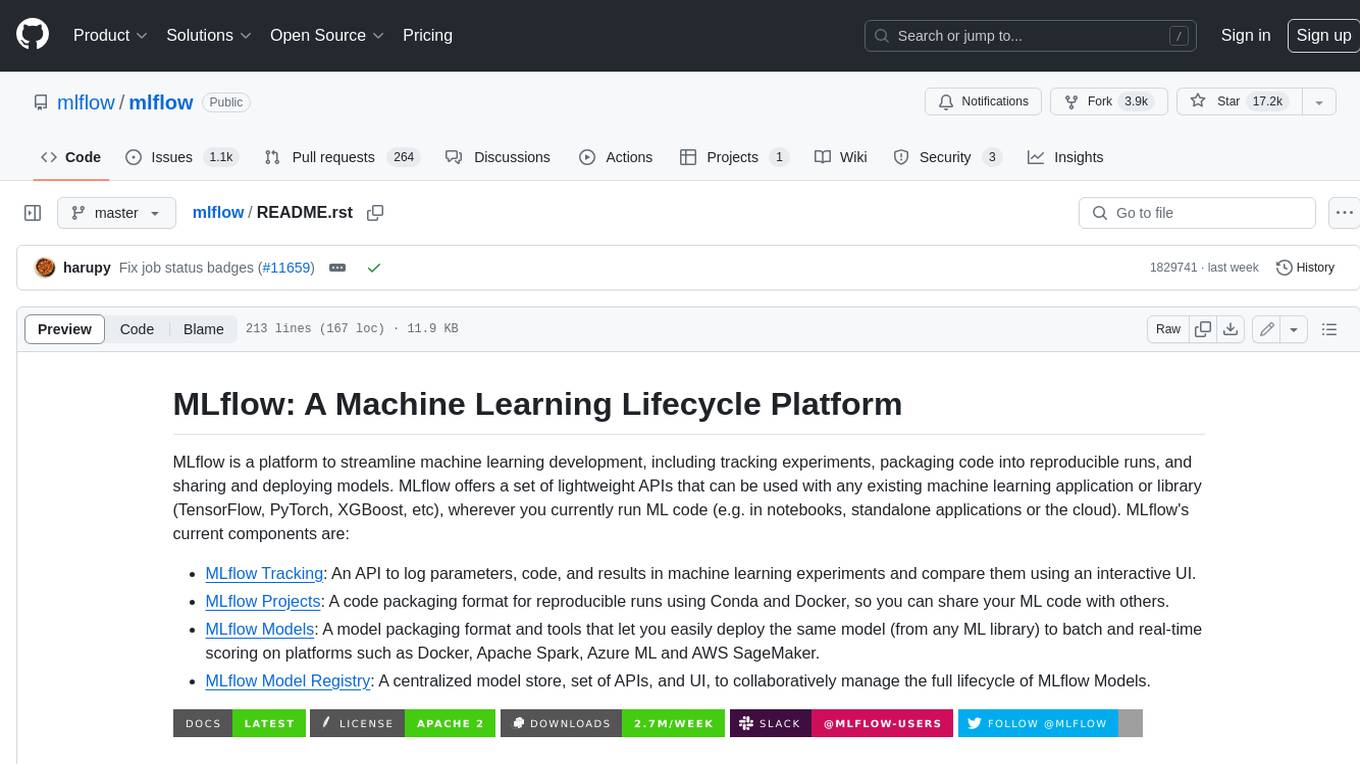
mlflow
MLflow is a platform to streamline machine learning development, including tracking experiments, packaging code into reproducible runs, and sharing and deploying models. MLflow offers a set of lightweight APIs that can be used with any existing machine learning application or library (TensorFlow, PyTorch, XGBoost, etc), wherever you currently run ML code (e.g. in notebooks, standalone applications or the cloud). MLflow's current components are:
* `MLflow Tracking
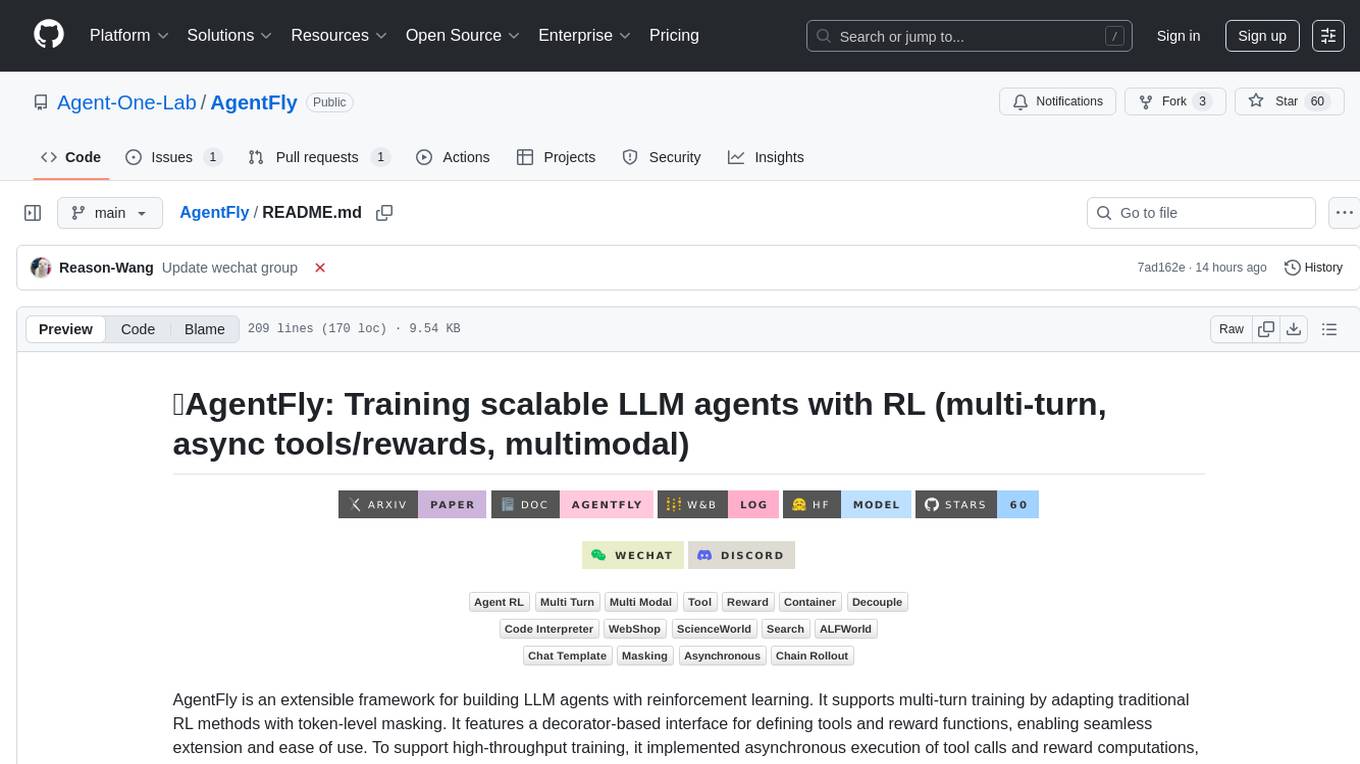
AgentFly
AgentFly is an extensible framework for building LLM agents with reinforcement learning. It supports multi-turn training by adapting traditional RL methods with token-level masking. It features a decorator-based interface for defining tools and reward functions, enabling seamless extension and ease of use. To support high-throughput training, it implemented asynchronous execution of tool calls and reward computations, and designed a centralized resource management system for scalable environment coordination. A suite of prebuilt tools and environments are provided.
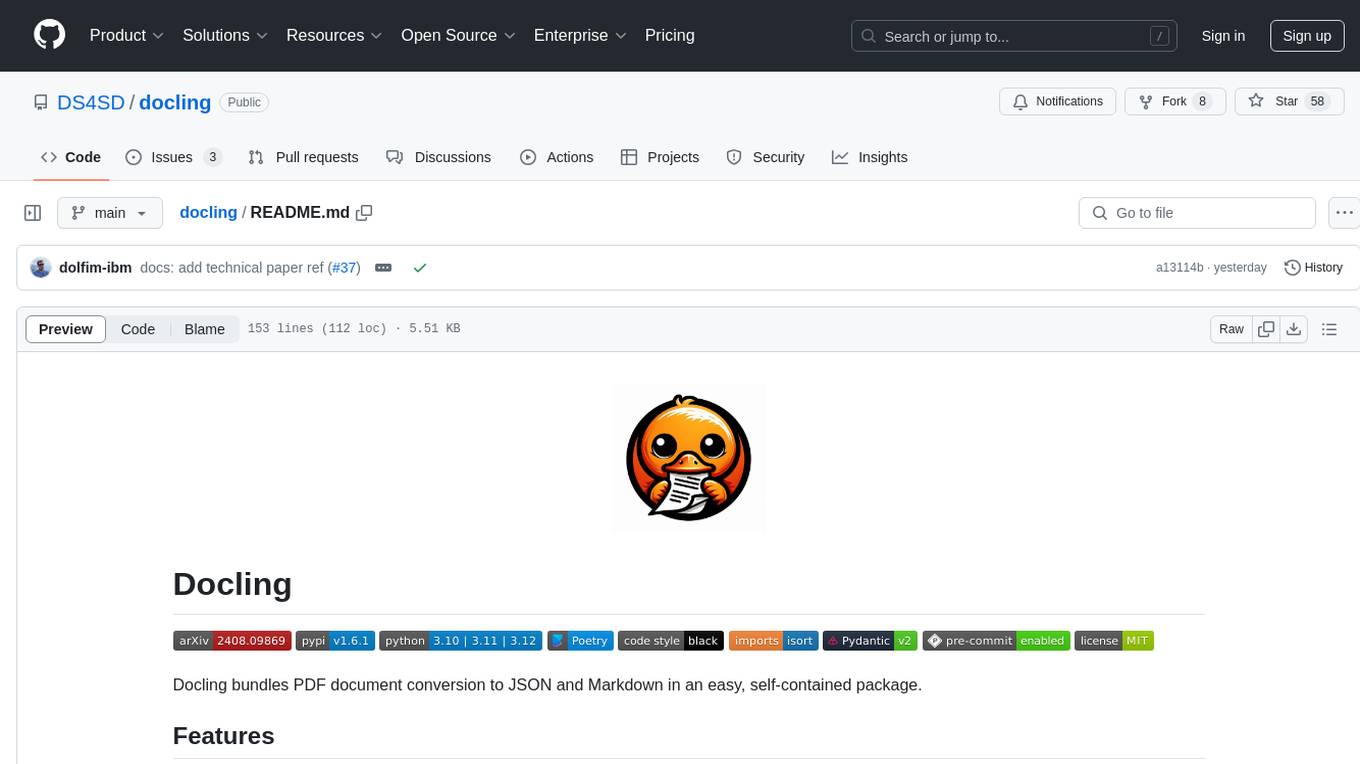
docling
Docling is a tool that bundles PDF document conversion to JSON and Markdown in an easy, self-contained package. It can convert any PDF document to JSON or Markdown format, understand detailed page layout, reading order, recover table structures, extract metadata such as title, authors, references, and language, and optionally apply OCR for scanned PDFs. The tool is designed to be stable, lightning fast, and suitable for macOS and Linux environments.

agents
The LiveKit Agent Framework is designed for building real-time, programmable participants that run on servers. Easily tap into LiveKit WebRTC sessions and process or generate audio, video, and data streams. The framework includes plugins for common workflows, such as voice activity detection and speech-to-text. Agents integrates seamlessly with LiveKit server, offloading job queuing and scheduling responsibilities to it. This eliminates the need for additional queuing infrastructure. Agent code developed on your local machine can scale to support thousands of concurrent sessions when deployed to a server in production.

StratosphereLinuxIPS
Slips is a powerful endpoint behavioral intrusion prevention and detection system that uses machine learning to detect malicious behaviors in network traffic. It can work with network traffic in real-time, PCAP files, and network flows from tools like Suricata, Zeek/Bro, and Argus. Slips threat detection is based on machine learning models, threat intelligence feeds, and expert heuristics. It gathers evidence of malicious behavior and triggers alerts when enough evidence is accumulated. The tool is Python-based and supported on Linux and MacOS, with blocking features only on Linux. Slips relies on Zeek network analysis framework and Redis for interprocess communication. It offers a graphical user interface for easy monitoring and analysis.

HAMi
HAMi is a Heterogeneous AI Computing Virtualization Middleware designed to manage Heterogeneous AI Computing Devices in a Kubernetes cluster. It allows for device sharing, device memory control, device type specification, and device UUID specification. The tool is easy to use and does not require modifying task YAML files. It includes features like hard limits on device memory, partial device allocation, streaming multiprocessor limits, and core usage specification. HAMi consists of components like a mutating webhook, scheduler extender, device plugins, and in-container virtualization techniques. It is suitable for scenarios requiring device sharing, specific device memory allocation, GPU balancing, low utilization optimization, and scenarios needing multiple small GPUs. The tool requires prerequisites like NVIDIA drivers, CUDA version, nvidia-docker, Kubernetes version, glibc version, and helm. Users can install, upgrade, and uninstall HAMi, submit tasks, and monitor cluster information. The tool's roadmap includes supporting additional AI computing devices, video codec processing, and Multi-Instance GPUs (MIG).
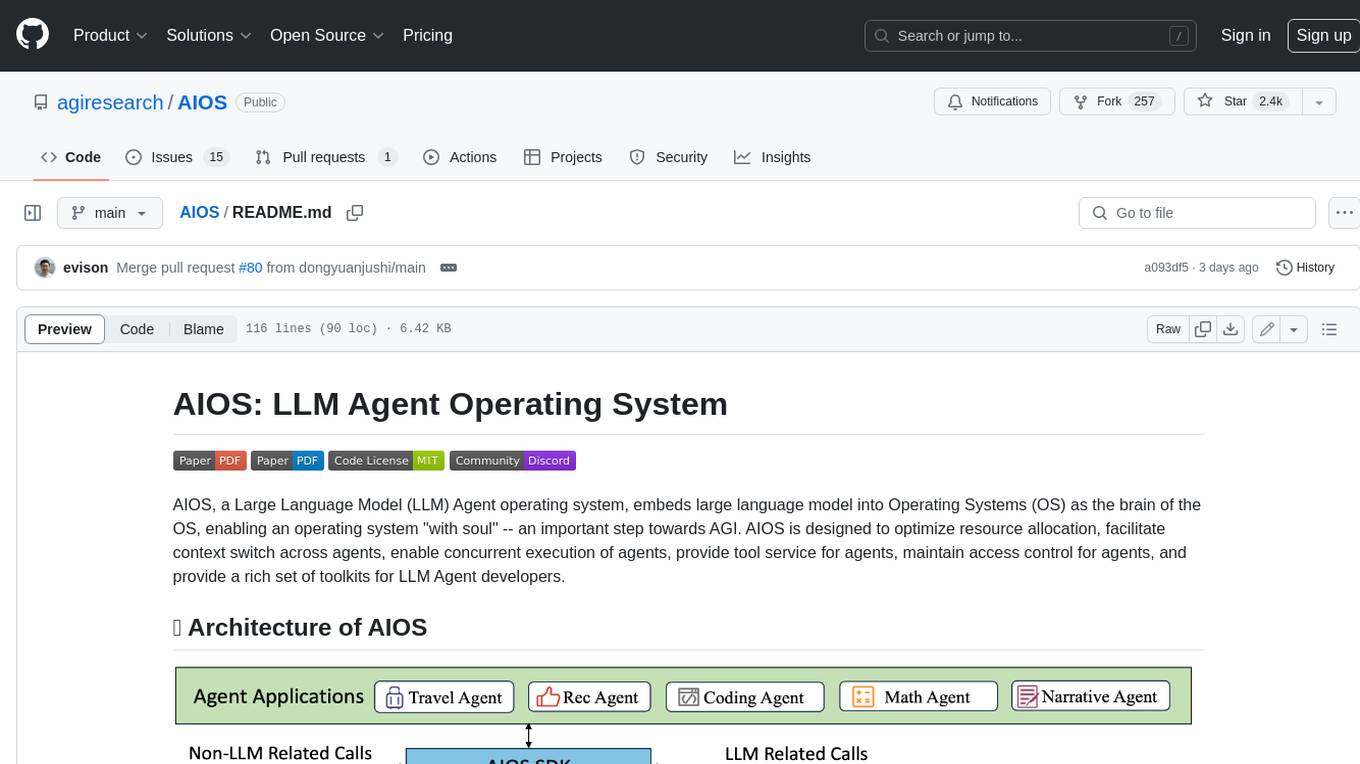
AIOS
AIOS, a Large Language Model (LLM) Agent operating system, embeds large language model into Operating Systems (OS) as the brain of the OS, enabling an operating system "with soul" -- an important step towards AGI. AIOS is designed to optimize resource allocation, facilitate context switch across agents, enable concurrent execution of agents, provide tool service for agents, maintain access control for agents, and provide a rich set of toolkits for LLM Agent developers.

scikit-llm
Scikit-LLM is a tool that seamlessly integrates powerful language models like ChatGPT into scikit-learn for enhanced text analysis tasks. It allows users to leverage large language models for various text analysis applications within the familiar scikit-learn framework. The tool simplifies the process of incorporating advanced language processing capabilities into machine learning pipelines, enabling users to benefit from the latest advancements in natural language processing.

crab
CRAB is a framework for building LLM agent benchmark environments in a Python-centric way. It is cross-platform and multi-environment, allowing the creation of agent environments supporting various deployment options. The framework offers easy-to-use configuration with the ability to add new actions and define environments seamlessly. CRAB also provides a novel benchmarking suite with tasks and evaluators defined in Python, along with a unique graph evaluator method for detailed metrics.

docling
Docling simplifies document processing, parsing diverse formats including advanced PDF understanding, and providing seamless integrations with the general AI ecosystem. It offers features such as parsing multiple document formats, advanced PDF understanding, unified DoclingDocument representation format, various export formats, local execution capabilities, plug-and-play integrations with agentic AI tools, extensive OCR support, and a simple CLI. Coming soon features include metadata extraction, visual language models, chart understanding, and complex chemistry understanding. Docling is installed via pip and works on macOS, Linux, and Windows environments. It provides detailed documentation, examples, integrations with popular frameworks, and support through the discussion section. The codebase is under the MIT license and has been developed by IBM.

brain4j
Brain4J is a lightweight, performant, and open-source machine learning framework for Java. Designed with portability and speed in mind, it is optimized for high performance and ideal for those looking to implement machine learning solutions in pure Java. The framework provides tools and functionalities to facilitate the development of machine learning models within Java applications, offering ease of use and efficiency.

moling
MoLing is a computer-use and browser-use MCP Server that implements system interaction through operating system APIs, enabling file system operations such as reading, writing, merging, statistics, and aggregation, as well as the ability to execute system commands. It is a dependency-free local office automation assistant. Requiring no installation of any dependencies, MoLing can be run directly and is compatible with multiple operating systems, including Windows, Linux, and macOS. This eliminates the hassle of dealing with environment conflicts involving Node.js, Python, Docker, and other development environments. Command-line operations are dangerous and should be used with caution. MoLing supports features like file system operations, command-line terminal execution, browser control powered by 'github.com/chromedp/chromedp', and future plans for personal PC data organization, document writing assistance, schedule planning, and life assistant features. MoLing has been tested on macOS but may have issues on other operating systems.

lightllm
LightLLM is a Python-based LLM (Large Language Model) inference and serving framework known for its lightweight design, scalability, and high-speed performance. It offers features like tri-process asynchronous collaboration, Nopad for efficient attention operations, dynamic batch scheduling, FlashAttention integration, tensor parallelism, Token Attention for zero memory waste, and Int8KV Cache. The tool supports various models like BLOOM, LLaMA, StarCoder, Qwen-7b, ChatGLM2-6b, Baichuan-7b, Baichuan2-7b, Baichuan2-13b, InternLM-7b, Yi-34b, Qwen-VL, Llava-7b, Mixtral, Stablelm, and MiniCPM. Users can deploy and query models using the provided server launch commands and interact with multimodal models like QWen-VL and Llava using specific queries and images.
For similar tasks
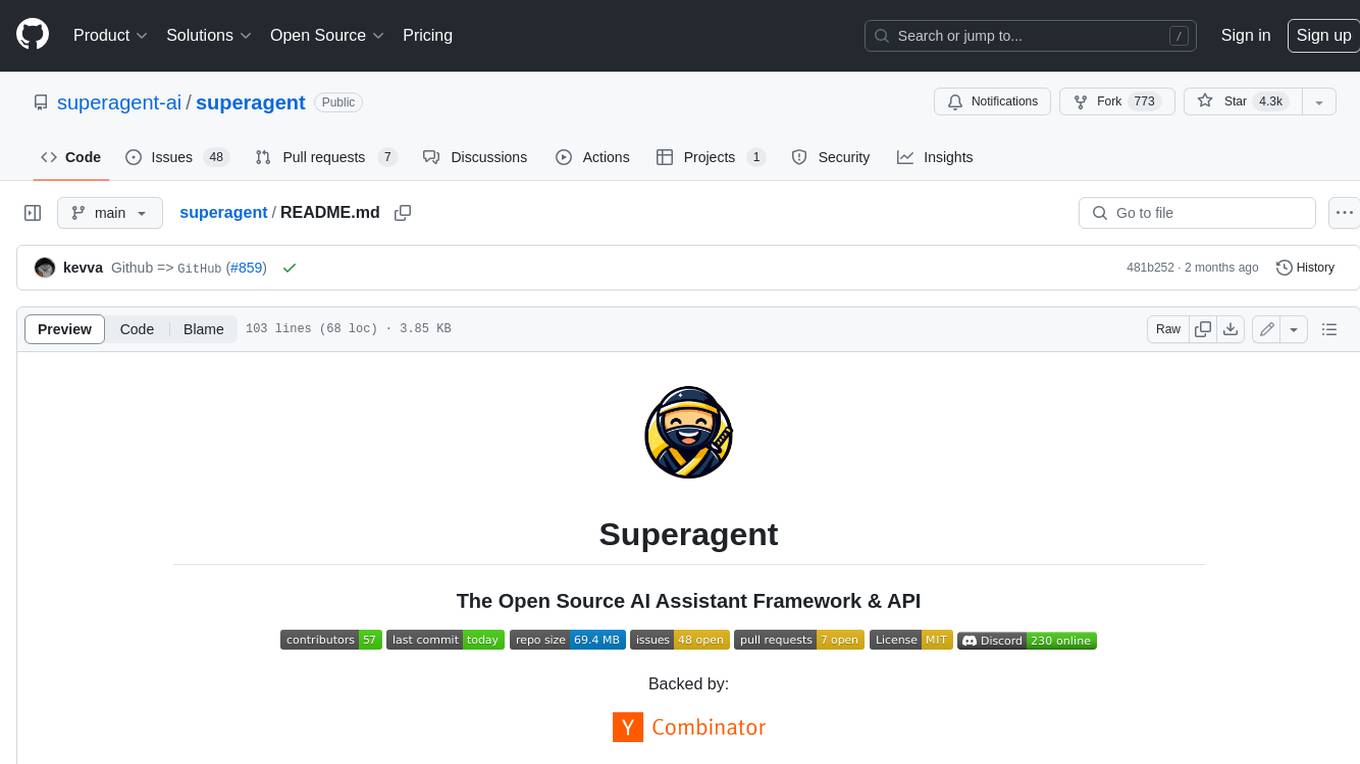
superagent
Superagent is an open-source AI assistant framework and API that allows developers to add powerful AI assistants to their applications. These assistants use large language models (LLMs), retrieval augmented generation (RAG), and generative AI to help users with a variety of tasks, including question answering, chatbot development, content generation, data aggregation, and workflow automation. Superagent is backed by Y Combinator and is part of YC W24.

Awesome-Segment-Anything
Awesome-Segment-Anything is a powerful tool for segmenting and extracting information from various types of data. It provides a user-friendly interface to easily define segmentation rules and apply them to text, images, and other data formats. The tool supports both supervised and unsupervised segmentation methods, allowing users to customize the segmentation process based on their specific needs. With its versatile functionality and intuitive design, Awesome-Segment-Anything is ideal for data analysts, researchers, content creators, and anyone looking to efficiently extract valuable insights from complex datasets.

simpletransformers
Simple Transformers is a library based on the Transformers library by HuggingFace, allowing users to quickly train and evaluate Transformer models with only 3 lines of code. It supports various tasks such as Information Retrieval, Language Models, Encoder Model Training, Sequence Classification, Token Classification, Question Answering, Language Generation, T5 Model, Seq2Seq Tasks, Multi-Modal Classification, and Conversational AI.

smile
Smile (Statistical Machine Intelligence and Learning Engine) is a comprehensive machine learning, NLP, linear algebra, graph, interpolation, and visualization system in Java and Scala. It covers every aspect of machine learning, including classification, regression, clustering, association rule mining, feature selection, manifold learning, multidimensional scaling, genetic algorithms, missing value imputation, efficient nearest neighbor search, etc. Smile implements major machine learning algorithms and provides interactive shells for Java, Scala, and Kotlin. It supports model serialization, data visualization using SmilePlot and declarative approach, and offers a gallery showcasing various algorithms and visualizations.

pgai
pgai simplifies the process of building search and Retrieval Augmented Generation (RAG) AI applications with PostgreSQL. It brings embedding and generation AI models closer to the database, allowing users to create embeddings, retrieve LLM chat completions, reason over data for classification, summarization, and data enrichment directly from within PostgreSQL in a SQL query. The tool requires an OpenAI API key and a PostgreSQL client to enable AI functionality in the database. Users can install pgai from source, run it in a pre-built Docker container, or enable it in a Timescale Cloud service. The tool provides functions to handle API keys using psql or Python, and offers various AI functionalities like tokenizing, detokenizing, embedding, chat completion, and content moderation.
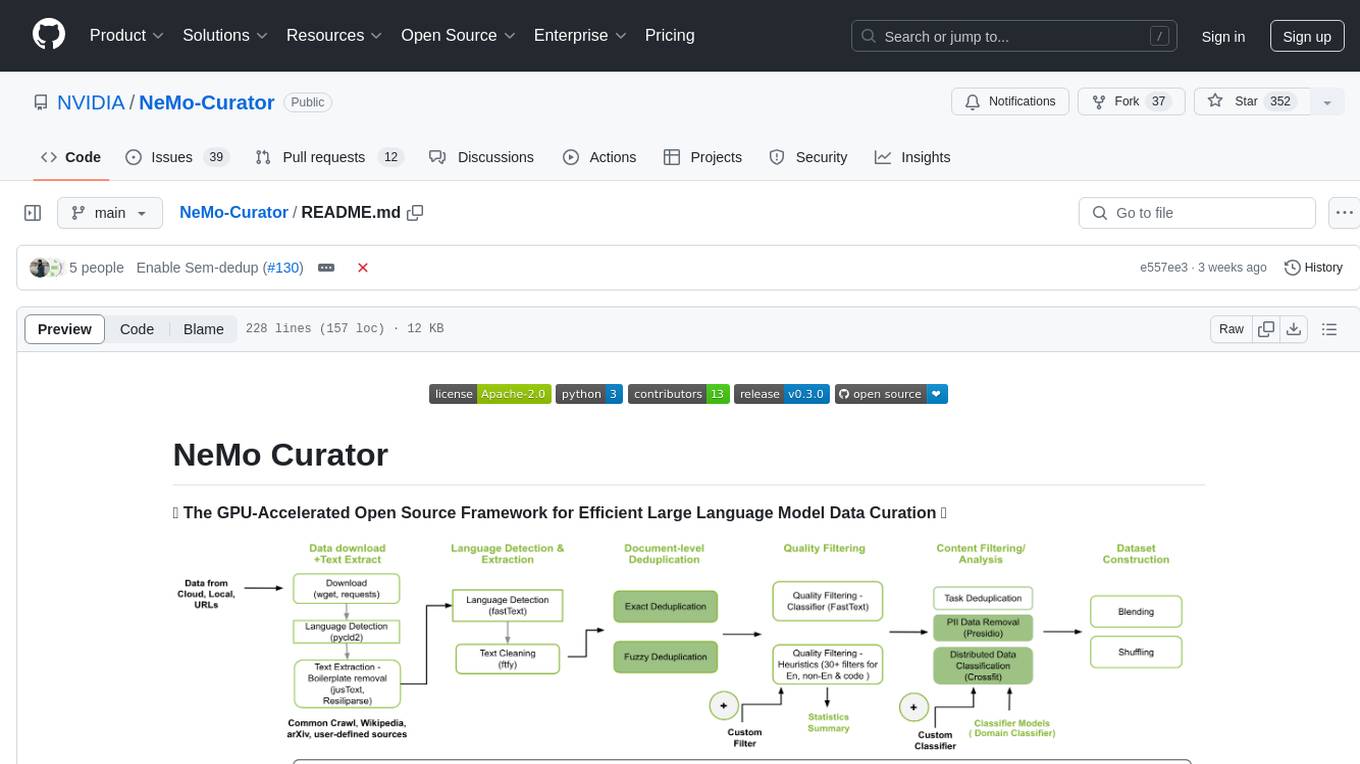
NeMo-Curator
NeMo Curator is a GPU-accelerated open-source framework designed for efficient large language model data curation. It provides scalable dataset preparation for tasks like foundation model pretraining, domain-adaptive pretraining, supervised fine-tuning, and parameter-efficient fine-tuning. The library leverages GPUs with Dask and RAPIDS to accelerate data curation, offering customizable and modular interfaces for pipeline expansion and model convergence. Key features include data download, text extraction, quality filtering, deduplication, downstream-task decontamination, distributed data classification, and PII redaction. NeMo Curator is suitable for curating high-quality datasets for large language model training.

bootcamp_machine-learning
Bootcamp Machine Learning is a one-week program designed by 42 AI to teach the basics of Machine Learning. The curriculum covers topics such as linear algebra, statistics, regression, classification, and regularization. Participants will learn concepts like gradient descent, hypothesis modeling, overfitting detection, logistic regression, and more. The bootcamp is ideal for individuals with prior knowledge of Python who are interested in diving into the field of artificial intelligence.

geoai
geoai is a Python package designed for utilizing Artificial Intelligence (AI) in the context of geospatial data. It allows users to visualize various types of geospatial data such as vector, raster, and LiDAR data. Additionally, the package offers functionalities for segmenting remote sensing imagery using the Segment Anything Model and classifying remote sensing imagery with deep learning models. With a focus on geospatial AI applications, geoai provides a versatile tool for processing and analyzing spatial data with the power of AI.
For similar jobs

weave
Weave is a toolkit for developing Generative AI applications, built by Weights & Biases. With Weave, you can log and debug language model inputs, outputs, and traces; build rigorous, apples-to-apples evaluations for language model use cases; and organize all the information generated across the LLM workflow, from experimentation to evaluations to production. Weave aims to bring rigor, best-practices, and composability to the inherently experimental process of developing Generative AI software, without introducing cognitive overhead.

LLMStack
LLMStack is a no-code platform for building generative AI agents, workflows, and chatbots. It allows users to connect their own data, internal tools, and GPT-powered models without any coding experience. LLMStack can be deployed to the cloud or on-premise and can be accessed via HTTP API or triggered from Slack or Discord.

VisionCraft
The VisionCraft API is a free API for using over 100 different AI models. From images to sound.

kaito
Kaito is an operator that automates the AI/ML inference model deployment in a Kubernetes cluster. It manages large model files using container images, avoids tuning deployment parameters to fit GPU hardware by providing preset configurations, auto-provisions GPU nodes based on model requirements, and hosts large model images in the public Microsoft Container Registry (MCR) if the license allows. Using Kaito, the workflow of onboarding large AI inference models in Kubernetes is largely simplified.

PyRIT
PyRIT is an open access automation framework designed to empower security professionals and ML engineers to red team foundation models and their applications. It automates AI Red Teaming tasks to allow operators to focus on more complicated and time-consuming tasks and can also identify security harms such as misuse (e.g., malware generation, jailbreaking), and privacy harms (e.g., identity theft). The goal is to allow researchers to have a baseline of how well their model and entire inference pipeline is doing against different harm categories and to be able to compare that baseline to future iterations of their model. This allows them to have empirical data on how well their model is doing today, and detect any degradation of performance based on future improvements.

tabby
Tabby is a self-hosted AI coding assistant, offering an open-source and on-premises alternative to GitHub Copilot. It boasts several key features: * Self-contained, with no need for a DBMS or cloud service. * OpenAPI interface, easy to integrate with existing infrastructure (e.g Cloud IDE). * Supports consumer-grade GPUs.

spear
SPEAR (Simulator for Photorealistic Embodied AI Research) is a powerful tool for training embodied agents. It features 300 unique virtual indoor environments with 2,566 unique rooms and 17,234 unique objects that can be manipulated individually. Each environment is designed by a professional artist and features detailed geometry, photorealistic materials, and a unique floor plan and object layout. SPEAR is implemented as Unreal Engine assets and provides an OpenAI Gym interface for interacting with the environments via Python.

Magick
Magick is a groundbreaking visual AIDE (Artificial Intelligence Development Environment) for no-code data pipelines and multimodal agents. Magick can connect to other services and comes with nodes and templates well-suited for intelligent agents, chatbots, complex reasoning systems and realistic characters.